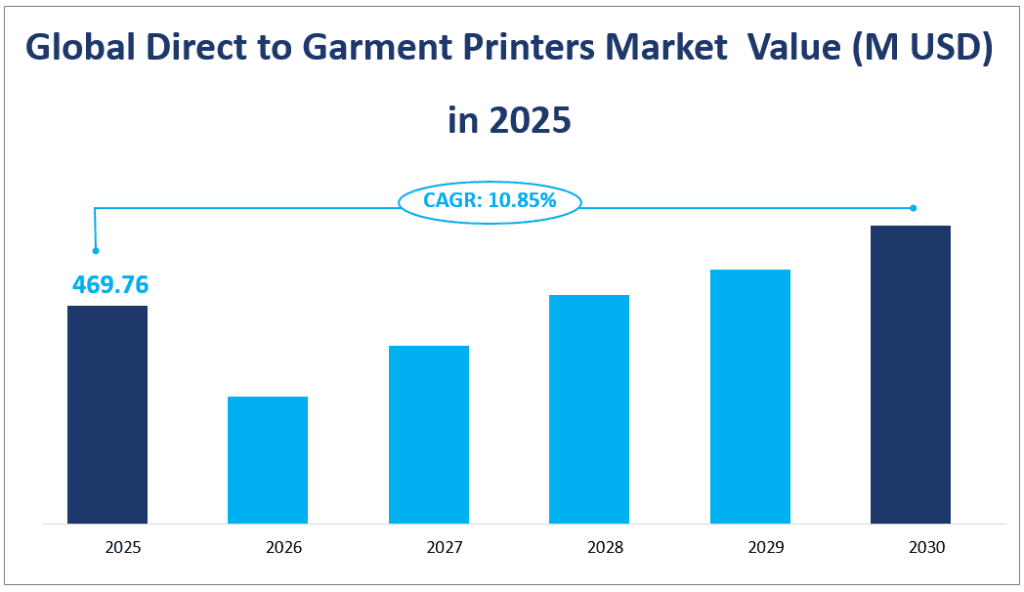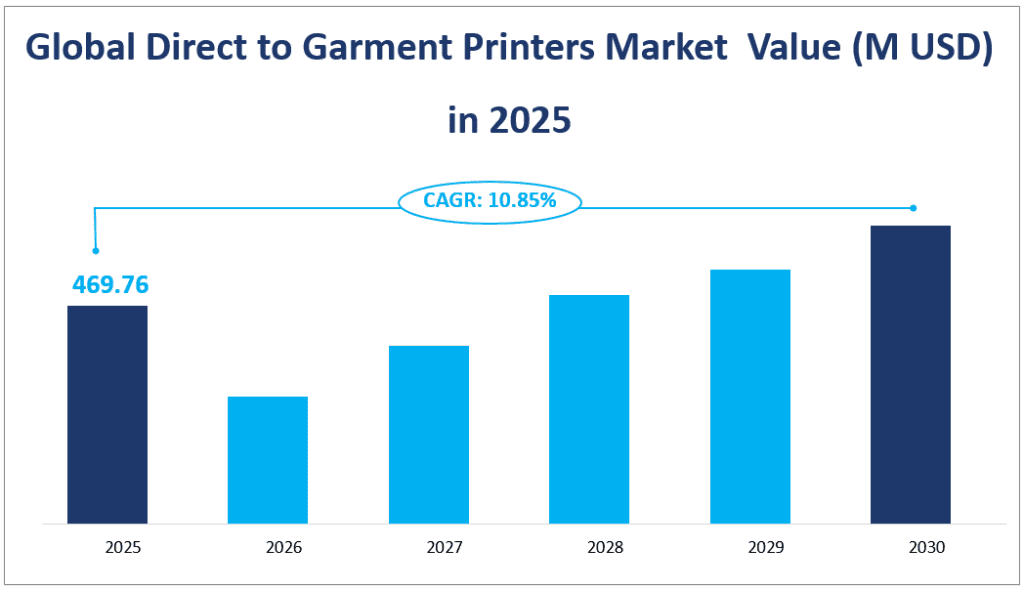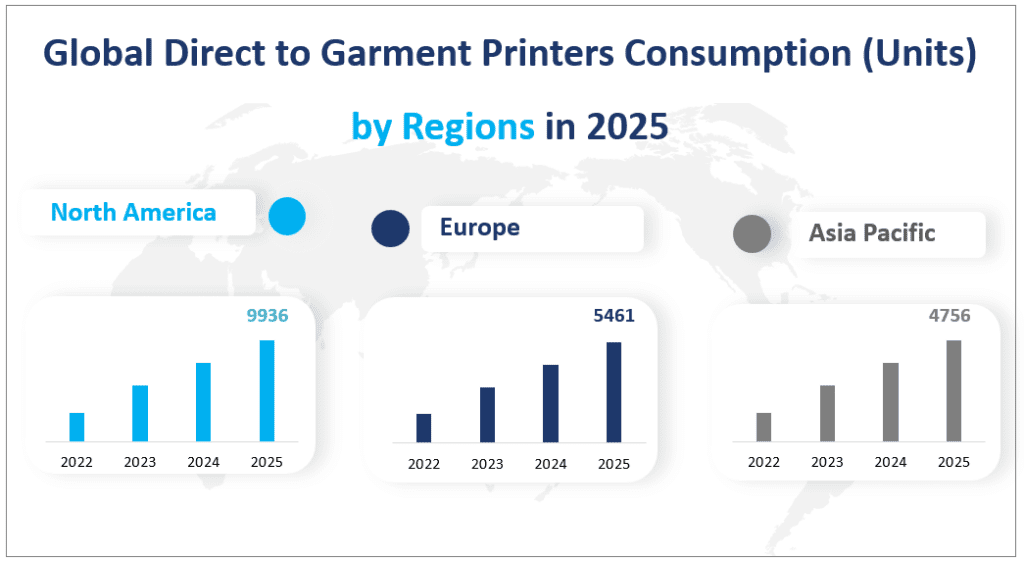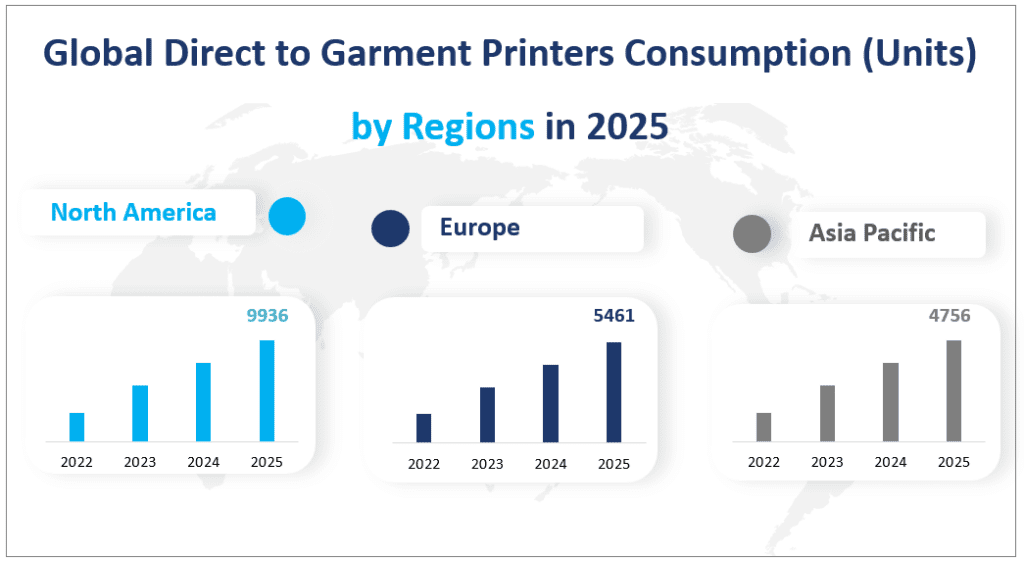1. Global Direct to Garment Printers Market Definition
The global Direct to Garment Printers market is projected to reach a revenue of $469.76 million in 2025 with a CAGR of 10.85% from 2025 to 2030.
Direct to Garment (DTG) printing is a revolutionary process that allows for the direct application of digital designs onto textiles using specialized inkjet technology. Unlike traditional screen printing, DTG printing eliminates the need for screens and setup costs, making it ideal for small-batch production and customization. The process involves a platen that holds the garment in place while the printer jets ink directly onto the fabric. This method not only enhances the precision and quality of prints but also reduces waste and environmental impact, aligning with the growing trend of sustainable manufacturing.
Global Direct to Garment Printers Market Value (M USD) in 2025


2. Driving Factors of Direct to Garment Printers Market
One of the primary drivers is the increasing demand for personalized clothing. As consumers’ disposable incomes rise and their preferences shift towards unique and customized apparel, DTG printing offers a cost-effective and efficient solution for small-batch production. This technology allows businesses to create bespoke designs without the high setup costs associated with traditional screen printing.
Another significant driver is the growing emphasis on sustainability in the textile industry. DTG printing uses less water and produces less waste compared to traditional methods, making it an environmentally friendly choice. This aligns with the global trend towards eco-conscious manufacturing and appeals to consumers who prioritize sustainability.
Technological advancements have also played a crucial role in the market’s growth. Improvements in print speed, resolution, and ink technology have made DTG printing more accessible and efficient. The development of new materials and inks has expanded the range of fabrics that can be printed on, further broadening the market’s potential.
3. Limiting Factors of Direct to Garment Printers Market
However, the market also faces several limiting factors. One of the primary challenges is the competition from traditional screen printing, which remains a dominant method for large-scale production due to its cost-effectiveness and simplicity. Screen printing is particularly suitable for solid and dynamic graphics, making it a preferred choice for certain applications.
Additionally, DTG printing has some limitations in terms of design layout and fabric selection. Certain materials, such as polyester, may not always provide the best results due to their waterproof nature, which can prevent ink from fusing properly. This can lead some businesses to opt for alternative printing methods, thereby limiting the demand for DTG printers.
Another limiting factor is the high initial investment required for DTG printers, which can be a barrier for small and medium-sized enterprises. The cost of equipment, maintenance, and ink can be prohibitive, especially for those without significant financial resources.
4. Analysis Direct to Garment Printers Market Segment
High Solid Acrylic (HSA): This type of DTG printer is expected to generate a revenue of $191.00 million in 2025. HSA printers are known for their durability and high-quality prints, making them popular in the market. They are particularly suitable for applications requiring vibrant colors and detailed designs. HSA printers use water-based inks that are thicker than traditional inks, providing a soft texture similar to plastisol ink but without environmental drawbacks.
Ready For Use (RFU): RFU printers are projected to achieve a revenue of $223.93 million in 2025. These printers are designed for ease of use and efficiency, making them ideal for small-scale production and customization. RFU printers come pre-configured with necessary settings and inks, reducing setup time and increasing productivity. Their ability to handle a wide range of fabrics and designs has contributed to their growing popularity.
Others: This category includes other types of DTG printers that do not fall under the HSA or RFU categories. These printers are expected to generate a revenue of $54.83 million in 2025. While they may not have the same market penetration as HSA and RFU printers, they offer specialized solutions for niche applications.
In 2025, RFU printers are expected to hold the largest market share, accounting for approximately 47.67% of the total market revenue. HSA printers follow closely with a market share of 40.66%, while other types of printers hold a smaller share of 11.67%. This indicates that RFU printers are more widely adopted due to their ease of use and versatility.
The dominance of RFU printers in terms of market share can be attributed to their user-friendly nature and adaptability to various applications. They are particularly favored by small businesses and home users who require flexibility and ease of operation. On the other hand, HSA printers, despite having a smaller market share, are growing at a faster rate due to their superior print quality and durability. This makes them an attractive choice for high-end applications and industries that prioritize print quality and longevity.
Analysis of Different Applications
Garment Factories: Garment factories are expected to consume 13,973 units of DTG printers in 2025. These factories utilize DTG printing for small-batch production, customization, and just-in-time manufacturing. The ability to produce high-quality prints with minimal waste and environmental impact makes DTG printing an ideal solution for garment factories. This segment includes large-scale manufacturers that produce customized apparel for various brands and retailers.
Household: Household applications are projected to consume 4,361 units in 2025. This segment includes home users who purchase DTG printers for personal use, such as creating custom T-shirts, baby clothes, and other personalized items. The growth in this segment is driven by the increasing demand for personalized clothing and the affordability of DTG printers for home use.
Other Commercial Applications: This category includes other commercial uses of DTG printers, such as promotional items, fashion accessories, and small-scale production for niche markets. These applications are expected to consume 3,004 units in 2025. This segment covers a wide range of industries that require customized printing solutions, from event organizers to small fashion designers.
In 2025, Garment Factories are expected to hold the largest market share, accounting for approximately 65.49% of the total market consumption. Household applications follow with a market share of 20.44%, while other commercial applications hold a smaller share of 14.08%. This indicates that garment factories are the primary drivers of the DTG printers market.
The dominance of Garment Factories in terms of market share can be attributed to their large-scale adoption of DTG printing for small-batch production and customization. The ability to produce high-quality prints with minimal waste and environmental impact makes DTG printing an attractive solution for garment manufacturers. This segment’s growth is driven by the increasing demand for personalized and sustainable clothing, as well as the need for flexible production processes that can quickly adapt to changing market trends.
Market Revenue and Share by Segment
| Revenue (M USD) in 2025 | Market Share in 2025 | ||
| By Type | HSA (High Solid Acrylic) | 191.00 | 40.66% |
| RFU (Ready For Use) | 223.93 | 47.67% | |
| By Application | Garment Factory | 13973 | 65.49% |
| Household | 4361 | 20.44% |
5. Regional Direct to Garment Printers Market
North America is expected to consume 9936 units of DTG printers in 2025. This region has historically been the largest market for DTG printers, driven by a high demand for personalized apparel and a strong presence of innovative printing technologies. The United States, in particular, is a significant contributor to this consumption, with a growing number of small and medium-sized enterprises (SMEs) adopting DTG printing for custom T-shirt production and other personalized items.
Europe is projected to consume 5461 units in 2025. The region’s market is driven by a combination of fashion-forward consumers and a robust manufacturing base. Countries like Germany, the UK, and Italy are key players in this region, with a strong focus on high-quality, sustainable printing solutions. The demand for eco-friendly printing processes and the growing trend of customization are key drivers in the European market.
The Asia-Pacific region is expected to consume 4,756 units in 2025. This region is characterized by rapid industrialization and a growing middle class, leading to increased demand for personalized clothing. China and Japan are the leading markets within this region, with China focusing on large-scale production and Japan on high-end, precision printing. The region’s growth is also supported by the increasing adoption of DTG printing in emerging markets like India and Southeast Asia.
Latin America is projected to consume 645 units in 2025. While this region has a smaller market compared to North America and Asia-Pacific, it is experiencing significant growth. Brazil and Mexico are the key markets, with a growing demand for customized apparel driven by a young, fashion-conscious population. The region’s market is also supported by the increasing availability of affordable DTG printing solutions.
North America is projected to be the largest regional market by consumption in 2025. This region’s dominance is attributed to its strong industrial base, high demand for personalized clothing, and a favorable business environment for innovation and technology adoption.
Global Direct to Garment Printers Consumption (Units) by Regions in 2025


6. Top 3 Companies in the Direct to Garment Printers Market
Company Introduction and Business Overview:
Kornit Digital is a multinational company specializing in industrial and commercial solutions for the clothing, apparel, and textile industry. Established in 2002, Kornit Digital has offices in the United States, Asia-Pacific, Europe, and India, serving customers in over 100 countries. The company is renowned for its advanced DTG printing technology, which combines high-speed printing with eco-friendly inks.
Products Offered:
Kornit Digital offers a range of DTG printers, including the Kornit Avalanche HD6, which is designed for high-volume production and features advanced ink recirculation systems and bulk ink containers. The company also offers the Kornit Presto, a high-speed DTG printer suitable for roll-to-roll fabric printing.
Company Introduction and Business Overview:
M&R Printing Equipment is the world’s largest manufacturer of screen printing equipment for the graphic and textile industries. Established in 1985, the company is headquartered in the United States and is known for its high-quality, innovative printing solutions. M&R’s products are used by a wide range of industries, from small businesses to large-scale manufacturers.
Products Offered:
M&R offers a variety of DTG printing solutions, including the EZPrep™ Pretreatment System, which automates the pretreatment process for DTG printing. This system ensures consistent print quality and reduces production time, making it ideal for high-volume production.
Company Introduction and Business Overview:
Brother Industries, Ltd. is a Japanese multinational electronic and electrical equipment company, established in 1908. The company offers a wide range of products, including printers, sewing machines, and typewriters. Brother’s DTG printers are designed for ease of use and high-quality printing, making them popular among small businesses and home users.
Products Offered:
Brother’s DTG printer lineup includes the GTXpro, a high-speed, user-friendly printer designed for small-batch production and customization. The GTXpro features automatic cleaning processes and advanced inkjet technology, ensuring high-quality prints with minimal maintenance.
Major Players
| Company Name | Plant Locations | Market Distribution |
| Kornit Digital | Mainly in Israel | Mainly in the United States, Asia-Pacific, Europe |
| M&R Printing Equipment | Mainly in the USA | Worldwide |
| Brother | Mainly in Japan, the USA | Worldwide |
| Epson | Mainly in Japan | Americas, Europe, Asia, Oceania, the Middle East and Africa |
| Ricoh | Mainly in Japan | Worldwide |
| Aeoon Technologies | Mainly in Austria | Worldwide |
| Polyprint | Mainly in Europe | Worldwide |
| Omniprint | Mainly in the USA | Mainly in the USA, Europe |
| ROQ International | Mainly in Portugal | Worldwide |
| ColDesi | Mainly in the USA | Mainly in North America |
| CNTop | Mainly in China | Mainly in Asia-Pacific, Europe, the USA |
| SinoColor | Mainly in China | Worldwide |
1 Direct to Garment Printers Market Overview
1.1 Product Overview and Scope of Direct to Garment Printers
1.2 Direct to Garment Printers Segment by Type
1.2.1 Global Direct to Garment Printers Sales Growth Rate Comparison by Type (2016-2027)
1.2.2 Different Types of Direct to Garment Printers
1.3 Market Analysis by Applications
1.3.1 Direct to Garment Printers Consumption Comparison by Application (2016-2027)
1.3.2 Different Applications of Direct to Garment Printers
1.4 Global Market Growth Prospects
1.4.1 Global Direct to Garment Printers Revenue Estimates and Forecasts (2016-2027)
1.4.2 Global Direct to Garment Printers Capacity Estimates and Forecasts (2016-2027)
1.5 Global Market Size by Region
1.5.1 Global Direct to Garment Printers Market Size Estimates and Forecasts by Region: 2016 VS 2021 VS 2027
1.5.2 North America Direct to Garment Printers Estimates and Forecasts (2016-2027)
1.5.3 Europe Direct to Garment Printers Estimates and Forecasts (2016-2027)
1.5.4 Japan Direct to Garment Printers Estimates and Forecasts (2016-2027)
1.5.5 China Direct to Garment Printers Estimates and Forecasts (2016-2027)
2 Market Competition by Manufacturers
2.1 Global Direct to Garment Printers Production and Market Share by Manufacturer
2.2 Global Direct to Garment Printers Revenue and Market Share by Manufacturer
2.3 Direct to Garment Printers Market Share by Company Type (Tier 1, Tier 2 and Tier 3)
2.4 Global Direct to Garment Printers Average Price by Manufacturers
2.5 Manufacturers Direct to Garment Printers Production Sites, Area Served
2.6 Direct to Garment Printers Market Competitive Situation and Trends
2.6.1 Global Top 5 and Top 10 Players Market Share by Revenue
2.6.2 Mergers & Acquisitions, Expansion
3 Production Capacity by Regions
3.1 Global Direct to Garment Printers Retrospective Market Scenario in Capacity by Region: 2016-2021
3.2 Global Direct to Garment Printers Revenue Market Share by Region 2016-2021
3.3 Global Direct to Garment Printers Production, Revenue, Price and Gross Margin (2016-2021)
3.4 North America Direct to Garment Printers Production
3.4.1 North America Direct to Garment Printers Production Growth Rate (2016-2021)
3.4.2 North America Direct to Garment Printers Production Capacity, Revenue, Price and Gross Margin (2016-2021)
3.5 Europe Direct to Garment Printers Production
3.5.1 Europe Direct to Garment Printers Production Growth Rate (2016-2021)
3.5.2 Europe Direct to Garment Printers Production Capacity, Revenue, Price and Gross Margin (2016-2021)
3.6 Japan Direct to Garment Printers Production
3.6.1 Japan Direct to Garment Printers Production Growth Rate (2016-2021)
3.6.2 Japan Direct to Garment Printers Production Capacity, Revenue, Price and Gross Margin (2016-2021)
3.7 China Direct to Garment Printers Production
3.7.1 China Direct to Garment Printers Production Growth Rate (2016-2021)
3.7.2 China Direct to Garment Printers Production Capacity, Revenue, Price and Gross Margin (2016-2021)
4 Direct to Garment Printers Consumption by Regions
4.1 Global Direct to Garment Printers Retrospective Market Scenario in Consumption by Region: 2016-2021
4.1.1 Global Direct to Garment Printers Consumption by Region
4.1.2 Global Direct to Garment Printers Consumption Market Share by Region
4.2 North America Direct to Garment Printers Consumption
4.2.1 North America Direct to Garment Printers Consumption by Country (2016-2021)
4.2.2 North America Direct to Garment Printers Revenue by Country (2016-2021)
4.2.3 United States Direct to Garment Printers Consumption and Growth (2016-2021)
4.2.4 Canada Direct to Garment Printers Consumption and Growth (2016-2021)
4.3 Europe Direct to Garment Printers Consumption
4.3.1 Europe Direct to Garment Printers Consumption by Country (2016-2021)
4.3.2 Europe Direct to Garment Printers Revenue by Country (2016-2021)
4.3.3 Germany Direct to Garment Printers Consumption and Growth (2016-2021)
4.3.4 France Direct to Garment Printers Consumption and Growth (2016-2021)
4.3.5 UK Direct to Garment Printers Consumption and Growth (2016-2021)
4.3.6 Italy Direct to Garment Printers Consumption and Growth (2016-2021)
4.3.7 Russia Direct to Garment Printers Consumption and Growth (2016-2021)
4.4 Asia Pacific Direct to Garment Printers Consumption
4.4.1 Asia Pacific Direct to Garment Printers Consumption by Country (2016-2021)
4.4.2 Asia Pacific Direct to Garment Printers Revenue by Country (2016-2021)
4.4.3 China Direct to Garment Printers Consumption and Growth (2016-2021)
4.4.4 Japan Direct to Garment Printers Consumption and Growth (2016-2021)
4.4.5 South Korea Direct to Garment Printers Consumption and Growth (2016-2021)
4.4.6 China Taiwan Direct to Garment Printers Consumption and Growth (2016-2021)
4.4.7 Southeast Asia Direct to Garment Printers Consumption and Growth (2016-2021)
4.4.8 India Direct to Garment Printers Consumption and Growth (2016-2021)
4.4.9 Australia Direct to Garment Printers Consumption and Growth (2016-2021)
4.5 Latin America Direct to Garment Printers Consumption
4.5.1 Latin America Direct to Garment Printers Consumption by Country (2016-2021)
4.5.2 Latin America Direct to Garment Printers Revenue by Country (2016-2021)
4.5.3 Brazil Direct to Garment Printers Consumption and Growth (2016-2021)
4.5.4 Mexico Direct to Garment Printers Consumption and Growth (2016-2021)
5 Global Direct to Garment Printers Production, Revenue, Price Trend by Type
5.1 Global Direct to Garment Printers Production and Market Share by Type (2016-2021)
5.2 Global Direct to Garment Printers Revenue Market Share by Type (2016-2021)
5.3 Global Direct to Garment Printers Price by Type (2016-2021)
6 Global Direct to Garment Printers Consumption Analysis by Application
6.1 Global Direct to Garment Printers Consumption Market Share by Applications (2016-2021)
6.2 Global Direct to Garment Printers Revenue Market Share by Applications (2016-2021)
6.3 Global Direct to Garment Printers Price by Applications (2016-2021)
7 Manufacturers Profiles
7.1 Kornit Digital
7.1.1 Business Overview
7.1.2 Direct to Garment Printers Product Introduction, Application and Specification
7.1.3 Kornit Digital Direct to Garment Printers Production, Price, Revenue, Gross Margin
7.1.4 Kornit Digital Recent Developments/Updates
7.2 M&R Printing Equipment
7.2.1 Business Overview
7.2.2 Direct to Garment Printers Product Introduction, Application and Specification
7.2.3 M&R Printing Equipment Direct to Garment Printers Production, Price, Revenue, Gross Margin
7.2.4 M&R Printing Equipment Recent Developments/Updates
7.3 Brother
7.3.1 Business Overview
7.3.2 Direct to Garment Printers Product Introduction, Application and Specification
7.3.3 Brother Direct to Garment Printers Production, Price, Revenue, Gross Margin
7.3.4 Brother Recent Developments/Updates
7.4 Epson
7.4.1 Business Overview
7.4.2 Direct to Garment Printers Product Introduction, Application and Specification
7.4.3 Epson Direct to Garment Printers Production, Price, Revenue, Gross Margin
7.4.4 Epson Recent Developments/Updates
7.5 Ricoh
7.5.1 Business Overview
7.5.2 Direct to Garment Printers Product Introduction, Application and Specification
7.5.3 Ricoh Direct to Garment Printers Production, Price, Revenue, Gross Margin
7.5.4 Ricoh Recent Developments/Updates
7.6 Aeoon Technologies
7.6.1 Business Overview
7.6.2 Direct to Garment Printers Product Introduction, Application and Specification
7.6.3 Aeoon Technologies Direct to Garment Printers Production, Price, Revenue, Gross Margin
7.7 Polyprint
7.7.1 Business Overview
7.7.2 Direct to Garment Printers Product Introduction, Application and Specification
7.7.3 Polyprint Direct to Garment Printers Production, Price, Revenue, Gross Margin
7.8 Omniprint
7.8.1 Business Overview
7.8.2 Direct to Garment Printers Product Introduction, Application and Specification
7.8.3 Omniprint Direct to Garment Printers Production, Price, Revenue, Gross Margin
7.9 ROQ International
7.9.1 Business Overview
7.9.2 Direct to Garment Printers Product Introduction, Application and Specification
7.9.3 ROQ International Direct to Garment Printers Production, Price, Revenue, Gross Margin
7.10 ColDesi
7.10.1 Business Overview
7.10.2 Direct to Garment Printers Product Introduction, Application and Specification
7.10.3 ColDesi Direct to Garment Printers Production, Price, Revenue, Gross Margin
7.11 CNTop
7.11.1 Business Overview
7.11.2 Direct to Garment Printers Product Introduction, Application and Specification
7.11.3 CNTop Direct to Garment Printers Production, Price, Revenue, Gross Margin
7.12 SinoColor
7.12.1 Business Overview
7.12.2 Direct to Garment Printers Product Introduction, Application and Specification
7.12.3 SinoColor Direct to Garment Printers Production, Price, Revenue, Gross Margin
8 Direct to Garment Printers Manufacturing Cost Analysis
8.1 Direct to Garment Printers Key Raw Materials Analysis
8.1.1 Key Raw Materials
8.1.2 Price Trend of Key Raw Materials
8.1.3 Key Suppliers of Raw Materials
8.2 Proportion of Manufacturing Cost Structure
8.3 Labor Cost
8.3.1 Definition of Labor Cost
8.3.2 Labor Level
8.3.3 Labor Cost of Americas
8.3.4 Labor Cost of Asia Pacific
8.3.5 Labor Cost of Europe
8.4 Manufacturing Process Analysis of Direct to Garment Printers
8.5 Direct to Garment Printers Industrial Chain Analysis
9 Marketing Channel, Distributors and Customers
9.1 Marketing Channel
9.1.1 Direct Marketing
9.1.2 Indirect Marketing
9.1.3 Marketing Channel Development Trend
9.2 Direct to Garment Printers Distributors List
9.3 Direct to Garment Printers Customers
10 Market Dynamics
10.1 Direct to Garment Printers Industry Trends
10.2 Direct to Garment Printers Growth Drivers
10.3 Direct to Garment Printers Market Challenges
10.4 Direct to Garment Printers Market Restraints
11 Production and Supply Forecast
11.1 Global Forecasted Production of Direct to Garment Printers by Region (2022-2027)
11.2 North America Direct to Garment Printers Production, Revenue Forecast (2022-2027)
11.3 Europe Direct to Garment Printers Production, Revenue Forecast (2022-2027)
11.4 Japan Direct to Garment Printers Production, Revenue Forecast (2022-2027)
11.5 China Direct to Garment Printers Production, Revenue Forecast (2022-2027)
12 Consumption and Demand Forecast
12.1 Global Forecasted Consumption of Direct to Garment Printers by Region (2022-2027)
12.2 North America Direct to Garment Printers Consumption, Revenue Forecast (2022-2027)
12.3 Europe Direct to Garment Printers Consumption, Revenue Forecast (2022-2027)
12.4 Asia-Pacific Direct to Garment Printers Consumption, Revenue Forecast (2022-2027)
12.5 Latin America Direct to Garment Printers Consumption, Revenue Forecast (2022-2027)
13 Forecast by Type and By Application (2022-2027)
13.1 Global Production, Revenue and Price Forecast by Type (2022-2027)
13.1.1 Global Forecasted Production of Direct to Garment Printers by Type (2022-2027)
13.1.2 Global Forecasted Revenue of Direct to Garment Printers by Type (2022-2027)
13.1.3 Global Forecasted Price of Direct to Garment Printers by Type (2022-2027)
13.2 Global Forecasted Consumption of Direct to Garment Printers by Application (2022-2027)
14 Research Findings and Conclusion
15 Appendix
15.1 Methodology
15.2 Research Data Source
